How to Prevent Hearing Loss: Tips for Protecting Your Ears
The ear is a complex organ responsible for both hearing and balance. It is divided into three main parts: the outer ear, the middle ear, and the inner ear. Hearing loss occurs when there is damage or impairment to any part of the auditory system, from the outer ear to the brain. The diagnosis of hearing loss typically involves a comprehensive evaluation by an audiologist or hearing healthcare professional. We will discuss the following:
Physiology of the ear
Functions of the ear
Pathophysiology of the hearing loss
Types of hearing loss
Risk factors for hearing loss
Symptoms of hearing loss
Diagnosis of hearing loss
Complications of hearing loss
Prevention of hearing loss
Treatment of hearing loss
How to protect the ear
Ways to enhance the hearing
How to talk with someone with hearing loss
Medications that affect hearing
When to seek urgent medical care
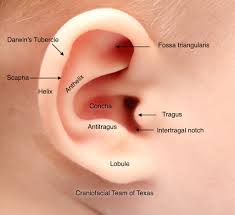
Physiology of the ear
The ear is a complex organ responsible for both hearing and balance. It is divided into three main parts: the outer ear, the middle ear, and the inner ear.
The outer ear includes the pinna (the visible part of the ear) and the ear canal. The pinna helps to collect sound waves and funnel them down the ear canal. The ear canal is lined with tiny hairs and wax-producing glands that help to protect the ear from foreign particles and infections.
The middle ear is separated from the outer ear by the eardrum, or tympanic membrane. The middle ear contains three small bones, known as the ossicles: the malleus, the incus, and the stapes. These bones help to transmit sound waves from the eardrum to the inner ear.
The inner ear contains the cochlea, which is responsible for hearing, and the vestibular system, which is responsible for balance. The cochlea is a spiral-shaped structure filled with fluid and lined with tiny hair cells. When sound waves reach the cochlea, they cause the fluid to move, which in turn causes the hair cells to bend. This bending generates electrical signals that are sent to the brain, which interprets them as sound.
The vestibular system includes three semicircular canals and two otolith organs. These structures help to detect movement and changes in position of the head and provide the brain with information about balance and spatial orientation.
Overall, the physiology of the ear is a complex and intricate process that involves the careful coordination of multiple structures and systems.
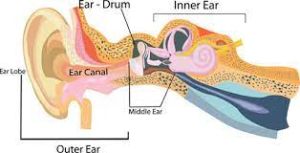
Functions of the ear
The ear is responsible for two primary functions: hearing and balance.
Hearing:
The ear is responsible for receiving and processing sound waves in the environment. The outer ear collects sound waves and funnels them down the ear canal to the eardrum, which vibrates in response to the sound waves. The vibrations of the eardrum are transmitted to the three small bones in the middle ear (the ossicles), which in turn transmit the vibrations to the cochlea in the inner ear. The cochlea contains hair cells that convert the mechanical vibrations into electrical signals, which are then transmitted to the brain via the auditory nerve. The brain interprets these signals as sound.
Balance:
The ear is also responsible for maintaining balance and spatial orientation. The vestibular system in the inner ear contains three semicircular canals and two otolith organs that detect changes in head position and movement. This information is transmitted to the brain and helps to coordinate movement and balance.
In addition to these primary functions, the ear also plays a role in other bodily functions, such as regulating blood pressure and heart rate through the vestibular system’s connection to the autonomic nervous system.
Pathophysiology of the hearing loss
This occurs when there is damage or impairment to any part of the auditory system, from the outer ear to the brain and can be classified into three main types:
- Conductive hearing loss occurs when there is an obstruction or damage to the outer or middle ear that prevents sound waves from reaching the inner ear. This is often temporary and can be caused by conditions such as ear infections, earwax buildup, or damage to the eardrum or ossicles (the tiny bones in the middle ear), can often be treated with medication, surgery, or hearing aids.
- Sensorineural hearing loss occurs when there is damage to the inner ear (cochlea) or the auditory nerve that carries signals from the cochlea to the brain. This is typically caused by aging, exposure to loud noise, infections, or genetic factors. It is usually permanent and can be treated with hearing aids, cochlear implants, or other assistive listening devices.
- Mixed hearing loss is a combination of conductive and sensorineural hearing loss. This means that there is damage or impairment to both the outer/middle ear and the inner ear or auditory nerve. It can be treated with a combination of medication, surgery, and hearing aids or other assistive listening devices.
Here are some terms that can describe the nature of hearing loss:
Bilateral: means that the hearing loss affects both ears.
Pre-lingual: This means the hearing loss occurred before the acquisition of language, typically before age 3.
Post-lingual: This means the hearing loss occurred after the acquisition of language, typically after age 3.
Symmetrical: This means that the hearing loss is similar in both ears.
Asymmetrical: This means that the hearing loss is more severe in one ear than the other.
Progressive: This means that the hearing loss gets worse over time.
Sudden: This means that the hearing loss occurs rapidly, often within a few hours or days.
Fluctuating: This means that the hearing loss varies in severity over time.
Stable: This means that the hearing loss does not change significantly over time.
Congenital: This means that the hearing loss is present at birth. It can occur due to genetic factors, such as mutations in genes that are involved in the development of the inner ear, or it can be caused by environmental factors, such as infections during pregnancy or complications during delivery.
Acquired: This means that the hearing loss occurs after birth, typically within the first few years of life and often due to factors such as infection, injury, or exposure to loud noise.
Delayed onset: This means that the hearing loss does not occur until later in life, often due to factors such as aging or noise exposure.
Risk factors for hearing loss

Aging: Age-related hearing loss, also known as presbycusis, is a common condition that affects many people as they get older.
Noise exposure: Exposure to loud noise, whether from a single loud event (such as an explosion) or prolonged exposure to loud noise (such as working in a loud factory)
Genetics: Some types of hearing loss are inherited, such as certain types of congenital hearing loss.
Ear infections: Chronic ear infections can cause damage to the ear
Medications: Certain medications, such as some antibiotics and chemotherapy drugs, can cause hearing loss as a side effect.
Ototoxic chemicals: Exposure to chemicals such as lead, mercury, and certain solvents
Trauma: Head injuries or trauma to the ear can cause
Diseases: Certain diseases, such as meningitis, measles, and mumps, can cause
Smoking
Cardiovascular disease
Ear wax, also known as cerumen, is a natural substance that is produced by glands in the ear canal. It serves as a protective barrier, trapping dirt and debris and preventing them from reaching the eardrum. When there is too much ear wax in the ear canal, it can block sound waves from reaching the eardrum, resulting in hearing loss or muffled sounds. Additionally, if the ear wax becomes impacted, it can cause pain, dizziness, and even infections. It is important to note that attempting to remove ear wax yourself can actually make the problem worse, as inserting cotton swabs or other objects into the ear canal can push the ear wax further in and cause damage to the ear.
Symptoms of hearing loss
The symptoms can vary depending on the severity and type, as well as the individual’s age and overall health. Here are some common symptoms:
Difficulty understanding speech, especially in noisy environments
Asking people to repeat themselves or speak more slowly and loudly
Turning up the volume on the television or radio
Difficulty hearing high-pitched sounds, such as a telephone ringing or a bird chirping
Trouble hearing sounds in the presence of background noise
Difficulty understanding conversation over the phone
Tinnitus, or ringing in the ears
Feeling like people are mumbling or speaking unclearly
Avoiding social situations due to difficulty hearing or understanding conversation
It’s important to seek medical attention if you experience any changes in your hearing or any of these symptoms, as they can be signs of an underlying medical condition.
Tinnitus is a condition where an individual hears ringing, buzzing, hissing, or other sounds in their ears that do not come from an external source. The sound can be constant or intermittent and can be present in one or both ears.
Diagnosis of hearing loss
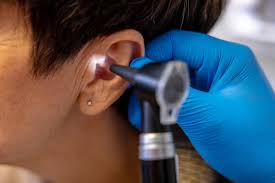
The diagnosis typically involves a comprehensive evaluation by an audiologist or hearing healthcare professional. Here are some common steps involved in the diagnosis:
Medical history: The healthcare provider will ask about the patient’s medical history, including any symptoms they are experiencing, any medications they are taking, and any medical conditions they have.
Physical examination: The healthcare provider will examine the patient’s ears and may look for signs of infection, blockage, or other abnormalities.
Hearing tests: are used to measure the patient’s ability to hear sounds at different frequencies and volumes. Tests may include pure-tone audiometry, speech audiometry, and/or other specialized tests.
Additional tests: In some cases, additional tests may be necessary to determine the cause of the hearing loss, such as imaging tests (like MRI or CT scan), or blood tests.
Complications of hearing loss
Communication difficulties: Hearing loss can make it difficult to communicate with others, especially in noisy environments or when multiple people are talking. This can lead to social isolation, frustration, and misunderstandings.
Cognitive decline: Studies have shown that hearing loss is associated with cognitive decline and an increased risk of dementia. This may be due to the increased cognitive load required to understand speech and other sounds, leading to mental fatigue and decreased cognitive function over time.
Emotional and psychological impact: Hearing loss can lead to feelings of frustration, anxiety, depression, and social isolation, which can have a significant impact on an individual’s mental health and quality of life.
Safety risks: Hearing loss can make it difficult to hear warning signals, such as fire alarms, car horns, or emergency sirens, which can put individuals at risk for accidents or injury.
Speech and language development: In children, hearing loss can lead to delays in speech and language development, which can have long-term consequences for academic achievement and social skills.
Workplace challenges: Hearing loss can make it difficult to perform certain job duties, leading to challenges in the workplace and potential loss of employment opportunities.
Here are some ways to prevent or reduce the risk of hearing loss:
Protect your ears from loud noises: Exposure to loud noises can damage your hearing over time. Wear earplugs or earmuffs when you are in noisy environments, such as concerts, sporting events, or construction sites. Limit the use of headphones or earbuds and keep the volume at a safe level.
Take breaks from loud noises: If you are exposed to loud noises for an extended period of time, take regular breaks to give your ears a rest.
Maintain good ear hygiene: Keep your ears clean and dry to reduce the risk of infections that can damage your hearing. However, it is important to avoid using cotton swabs or other objects to clean the ear canal, as this can push earwax further into the ear and potentially cause damage.
Manage chronic medical conditions: Certain medical conditions, such as diabetes and high blood pressure, can increase the risk of hearing loss. Manage these conditions with appropriate medical care.
Avoid ototoxic medications: Some medications can damage your hearing. Talk to your doctor about the potential risks of any medications you are taking.
Get regular hearing checkups: Regular hearing checkups can help detect hearing loss early, when it may be easier to treat. It is recommended to have a hearing test every 10 years up until age 50, and then every 3 years thereafter.
Be aware of noise levels in your environment: Be aware of the noise levels in your environment and take steps to reduce your exposure to loud noise whenever possible.
Avoid inserting objects into the ear: It is important to avoid inserting objects, such as cotton swabs, into the ear canal, as this can cause damage or push earwax further into the ear.
Protect the ears during water activities: Water in the ear canal can increase the risk of ear infections or damage to the ear. It is important to use earplugs or a swim cap to protect the ears during water activities.
Treatment of hearing loss
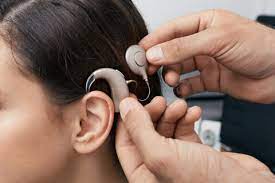
The treatment depends on the type and severity of the hearing loss, as well as the individual’s specific needs and preferences. Here are some common treatments options:
Hearing aids: are small electronic devices worn in or behind the ear that amplify sound and improve hearing. They come in different styles and types, including behind-the-ear, in-the-ear, and completely-in-the-canal. The hearing healthcare provider will help choose the right type of hearing aid based on the individual’s hearing loss and lifestyle needs.
Cochlear implants: are devices that are surgically implanted in the inner ear to bypass damaged hair cells and stimulate the auditory nerve directly. They are typically used for individuals with severe to profound hearing loss who do not benefit from hearing aids.
Assistive listening devices: such as FM systems, captioning, or telecoil systems, can improve hearing in specific situations, such as when watching TV, talking on the phone, or attending lectures.
Communication strategies: such as lip-reading, sign language, or speech therapy, can help improve communication skills for individuals with hearing loss.
Medications or surgery: In some cases, hearing loss may be caused by underlying medical conditions, such as ear infections or tumors, that can be treated with medication or surgery.
Natural remedies for hearing loss
While there are some natural remedies that may improve overall ear health, there is no scientific evidence to support the claim that they can effectively treat hearing loss. However, here are some natural remedies that may promote ear health:
A healthy diet: A balanced diet rich in vitamins and minerals, such as vitamin C, vitamin E, magnesium, and zinc, may help improve overall ear health.
Exercise: Regular exercise can help improve blood flow to the ears and promote overall ear health.
Quit smoking: Smoking can damage the blood vessels in the ear and increase.
Reduce stress: Stress can cause tension in the muscles of the ear and lead to hearing problems. Practicing relaxation techniques, such as yoga or meditation, may help reduce stress levels.
Avoid loud noises: Exposure to loud noises can damage the delicate hair cells in the inner ear. It is important to protect the ears from loud noises whenever possible.
Warm water
There is no scientific evidence to support the claim that warm water can improve or worsen hearing loss. However, warm water may be used for earwax removal or to soothe ear pain or discomfort. It is important to use warm water carefully and with caution to avoid causing damage to the ear. If someone is experiencing hearing loss, it is important to seek medical attention to determine the underlying cause and appropriate treatment options.
Oil
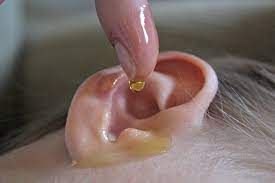
There is no scientific evidence to suggest that oil can improve or worsen hearing loss. However, some people use oils, such as olive oil or coconut oil, as a home remedy for earwax removal or to relieve ear pain or discomfort. It is important to use oils with caution and to avoid using them if there is a perforation in the eardrum or an underlying ear infection. In fact, introducing oil into the ear canal can make some ear infections worse. If someone is experiencing hearing loss, it is important to seek medical attention to determine the underlying cause and appropriate treatment options.
Carbamide
Carbamide, also known as urea peroxide, is a type of over-the-counter medication used for earwax removal. It works by softening and loosening earwax so that it can be easily removed from the ear canal. While carbamide can help remove earwax, there is no scientific evidence to suggest that it can improve or worsen hearing loss, it can be dangerous and may cause hearing loss if not used properly. It can also cause irritation and damage to the delicate skin in the ear canal if used in excess or if the concentration of the solution is too high. In some cases, using hydrogen peroxide to clean ear wax can also lead to an infection or even a perforated eardrum.
Herbal remedies
There is no scientific evidence to suggest that herbal remedies can improve or treat hearing loss. While some herbs may have anti-inflammatory or antioxidant properties that may benefit overall ear health, there is no research to suggest that they can effectively treat hearing loss. It is important to note that some herbal remedies may interact with medications or cause side effects. Before using any herbal remedies for ear health, it is important to consult a healthcare professional.
Here are some tips on how to protect the ears:
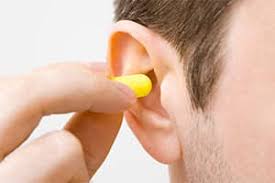
Ways to cope with hearing loss
Use hearing aids: Hearing aids can help amplify sounds and make it easier to hear in different environments. There are many different types of hearing aids available, and a healthcare professional can help determine the best type for each individual.
Consider assistive listening devices: Assistive listening devices, such as FM systems, can help improve hearing in specific situations, such as in noisy environments or when watching TV.
Communicate clearly with others: It is important to communicate clearly with others and let them know about any hearing loss. This can include asking others to speak louder or slower and facing them directly when speaking.
Reduce background noise: Background noise can make it difficult to hear conversations. It is important to reduce background noise as much as possible, such as by turning off the TV or radio.
Join support groups: Support groups can provide emotional support and help individuals with hearing loss connect with others who are experiencing similar challenges.
Seek professional counseling: Hearing loss can be challenging emotionally and mentally. Professional counseling can help individuals cope with the emotional effects of hearing loss.
Practice good self-care: It is important to practice good self-care, such as getting enough rest, eating a healthy diet, and exercising regularly. This can help improve overall well-being and make it easier to cope with hearing loss.
How to talk with someone with hearing loss
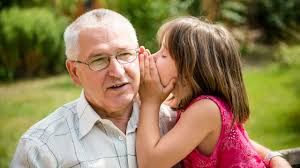
Communicating with someone who has hearing loss can be challenging, but there are some tips that can make it easier:
Get the person’s attention: Make sure you have the person’s attention before speaking to them. This can be done by waving your hand, tapping them on the shoulder, or saying their name.
Face the person: Face the person directly and maintain eye contact while speaking. This can help them to see your facial expressions and lip movements, which can make it easier to understand what you’re saying.
Speak clearly and slowly: Speak clearly and slowly, but don’t shout or exaggerate your lip movements. This can make it more difficult for the person to understand what you’re saying.
Use simple language: Use simple language and avoid using complex words or phrases. This can make it easier for the person to understand what you’re saying.
Repeat and rephrase: If the person doesn’t understand what you’re saying, repeat or rephrase what you said. Try to use different words or explain the concept in a different way.
Use visual aids: Visual aids, such as written notes or diagrams, can be helpful in communicating complex ideas.
Minimize background noise: Try to minimize background noise, such as by turning off the TV or radio. This can make it easier for the person to hear and understand what you’re saying.
Medications that affect hearing
Aminoglycoside antibiotics: These antibiotics are used to treat serious bacterial infections but can damage the hair cells in the inner ear, leading to hearing loss or tinnitus.
Loop diuretics: These medications are used to treat conditions such as high blood pressure and edema, but can cause hearing loss or tinnitus, especially at high doses.
Nonsteroidal anti-inflammatory drugs (NSAIDs): NSAIDs, such as ibuprofen and aspirin, can cause temporary hearing loss or tinnitus when taken in high doses or over a long period of time.
Chemotherapy drugs: Certain chemotherapy drugs can cause hearing loss or tinnitus as a side effect.
Antimalarial drugs: Antimalarial drugs, such as chloroquine and quinine, can cause hearing loss or tinnitus.
Antidepressants: Some types of antidepressants, such as tricyclic antidepressants, can cause hearing loss or tinnitus as a side effect.
Aspirin-containing products: Aspirin-containing products can cause temporary hearing loss or tinnitus when taken in high doses or over a long period of time.
Noise and hearing loss
Exposure to loud noise can cause hearing loss over time, especially if the exposure is prolonged or frequent. The loudness of sound is measured in units called decibels (dB) and sounds above 85 dB can cause damage to the hair cells in the inner ear, which can lead to hearing loss.
Some common sources of loud noise include:
Occupational noise: People who work in noisy environments, such as construction sites, factories, or music venues
Recreational noise: Activities such as listening to music at high volumes, attending concerts, or using power tools
Traffic noise: Living near a busy road or airport can expose individuals to constant loud noise
Personal listening devices: Listening to music or other audio content at high volumes through earbuds or headphones
When to seek urgent medical care
Seeking urgent medical care for hearing loss is crucial in certain situations, including:
- Sudden hearing loss in one or both ears, it’s essential to seek immediate medical attention. It can be a sign of a serious underlying condition, such as an infection, injury, or even a stroke.
- Severe pain or discomfort: If you experience severe pain, pressure, or discomfort in your ears along with hearing loss, it could indicate an infection or injury.
- Ear injury: If you injure your ear, such as by inserting a foreign object into it or sustaining a blow to the head, and experience hearing loss or other symptoms like bleeding or discharge from the ear.
- Gradual hearing loss accompanied by other concerning symptoms such as dizziness, ringing in the ears (tinnitus), or balance problems.
- Hearing loss after exposure to loud noise, such as an explosion or gunfire, seek urgent medical attention as it could indicate damage to the inner ear.
In addition to these situations, it’s essential to seek medical care for hearing loss if it significantly impacts your quality of life, interferes with your ability to communicate or perform daily activities, or if you have concerns about your hearing health. A healthcare provider can evaluate your condition, determine the underlying cause of the hearing loss and recommend appropriate treatment or interventions.
It’s always better to err on the side of caution and seek medical attention promptly if you have any concerns or experience any of the above symptoms. Early intervention can often lead to better outcomes and prevent further damage to your hearing.
Disclaimer: The information provided in this content is for general informational purposes only. It is not intended as medical or healthcare advice, diagnosis, or treatment. Always seek the advice of a qualified healthcare professional with any questions you may have regarding a medical condition or healthcare decisions.

